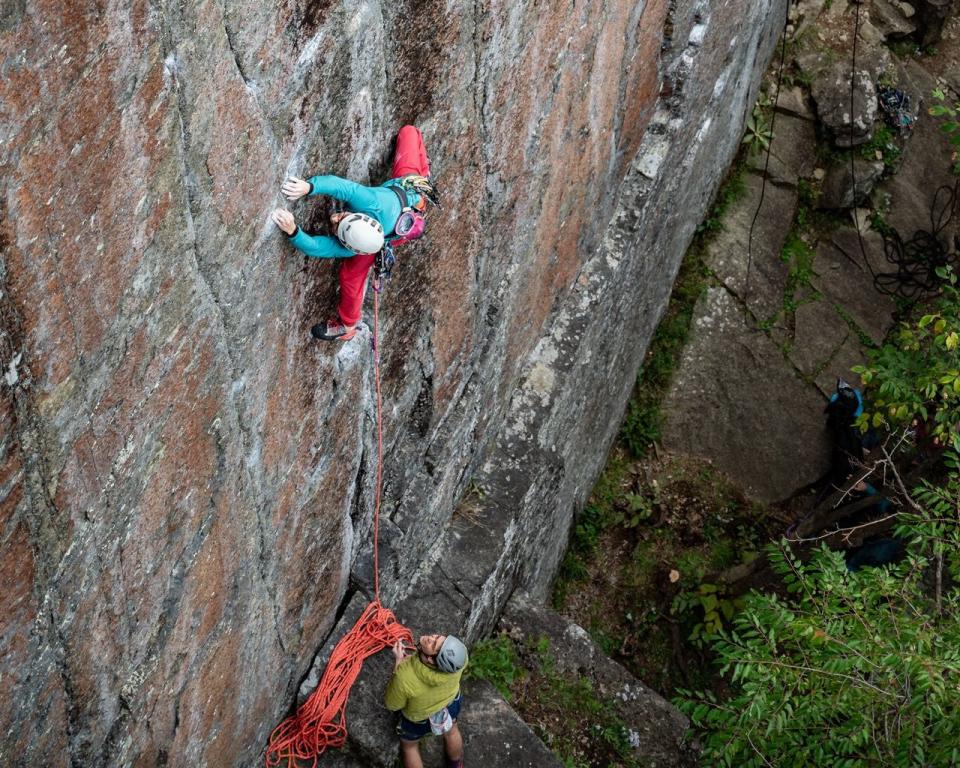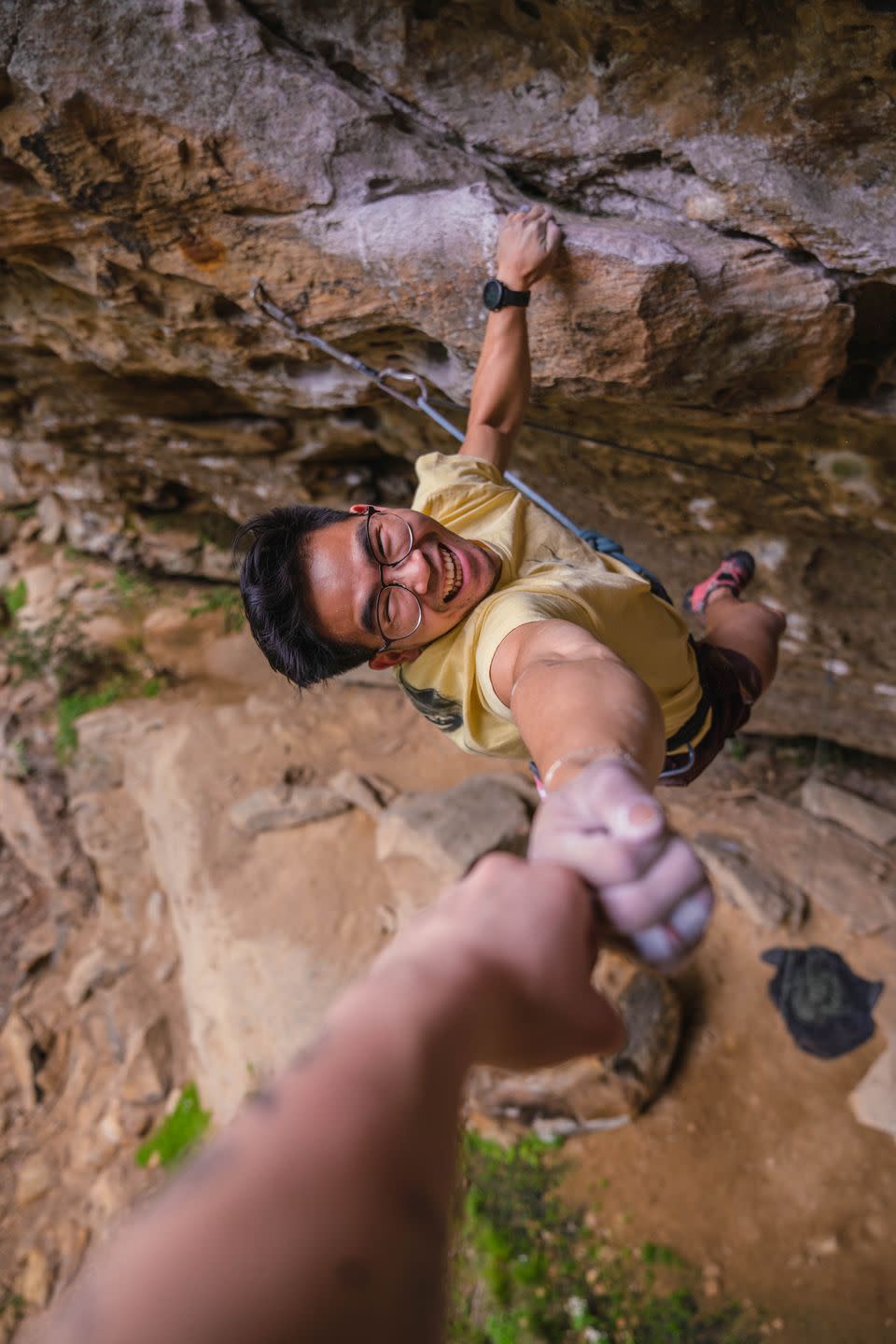How Trans Athletes Banded Together and Actually Defeated a Half-Baked Sports Ban

"Hearst Magazines and Yahoo may earn commission or revenue on some items through these links."
The announcement landed quietly in inboxes in early October. USA Climbing—the organization that governs competitive climbing in the United States—was unrolling a new policy on transgender participation in the sport. And for trans athletes, it wasn’t good news, because let’s face it: It hardly ever is.
Like many other regulations on trans participation in sports, the USAC policy is obsessed with testosterone levels and the eligibility of trans women and trans femmes—and the restrictions are overwhelming. Any trans climbers using testosterone or spironolactone (a feminizing hormone therapy) would have to apply for a Therapeutic Use Exemption (TUE) from the United States Anti-Doping Agency, which involves providing a letter from the athlete describing their personal experiences and medical transition, documentation from a psychologist or psychiatrist, detailed medical history including endocrinology, laboratory, and surgical reports, and an ongoing treatment plan—essentially treating hormone replacement therapy as a doping issue. On top of that, trans femme athletes on the international track, ages 14 and up, must maintain certain testosterone levels for a year with testing at the 12-month, six-month, and six-week mark preceding competition, as well as throughout the competitive season.
With so many requirements, the policy seems less about climbing and more about jumping through hoops. And in practice, the dense and frankly confusing thicket of rules would end up barring many trans women—and especially trans girls—from competing altogether.
Imagine this scenario: A trans girl as young as 13 would have to come out publicly, find a psychiatrist to diagnose her with gender dysphoria so she could begin medical transition, continue hormone replacement therapy or puberty blockers for at least a year to manage her testosterone levels, disclose her highly sensitive personal and medical information to a sports organization, get regular, expensive testing, and also focus on the craft of her sport and still, somehow, have fun. And that’s if she lives in a state that allows minors to access trans health care at all, which is a pretty big if in our current era of rampant transphobia. The Human Rights Campaign found that over 35 percent of trans youth ages 13 to 17 live in states with bans on gender affirming care. Now, more than ever, trans girls and women are being placed in an impossible double bind.
But the climbing community—a diverse mix of competitive and recreational climbers, inclusive affinity groups, crunchy nature buffs, daredevils, and people of all ages drawn in by the physical and therapeutic potential of the sport—wasn’t going to accept the new rules without a fight.
“When the policy was announced, it came as a huge shock to myself and frankly, every member of my community that I know,” says Kristen Fiore, a trans climbing coach and guide. “It’s entirely heartbreaking, and I had a full meltdown of crying and being like ‘How has climbing, the sport that I love so much, the community that has held me so dearly, gone the way of many other sports that we’ve seen?’”

Indeed, USAC is just one of the many sports organizations going on the offensive when it comes to trans athletes. In 2022, World Swimming, a governing body for competitive swimming, implemented an effective ban for trans women. Track and field, too, announced last year that trans women were officially barred from women’s elite competitions. Even competitive chess announced a ban on trans women in 2023—yes, chess, which underscores how thin the rationale behind these bans really is. Many of these policies are being challenged (for instance, swimming champion Lia Thomas filed a dispute against a World Aquatics policy that limits trans swimmers’ Olympic eligibility), but these decisions still ripple into the lives of everyday people. Over the last few years, there’s been a wave of anti-trans legislation seeking to bar trans youth, and especially trans girls, from K–12 sports in both schools and publicly-funded facilities. And it’s policies like USAC’s that embolden anti-trans decision-makers across all levels of society.
Within weeks of the October policy announcement, Fiore was in touch with other trans climbers across the country. Together, they founded Trans Climbers Belong (TCB), a grassroots initiative organizing against the policy and working to build solidarity for trans athletes across the wider climbing community. “Our demand, which has never changed since day one, is that this policy needs to be rewritten with trans, intersex, and non-binary climbers,” says Fiore. “And by rewritten, I mean in the writer’s room, not just reviewing things. We’re asking for trans writers, not trans spell checkers.”
Trans Climbers Belong published two open letters—one penned by Fiore herself in her capacity as a coach and one from parents of USAC athletes outlining their specific policy concerns and recommendations—as well as a letter of solidarity from organizers, gym owners, coaches, instructors, parents, athletes, and other industry members. Chief among their requests was making sure trans, intersex, and non-binary climbers got a seat at the table. An online petition, launched by Trans Climbers Belong, garnered over 11,000 signatures and other climbers took to social media to express their disappointment.
Crucially, TCB organizers also encouraged gym owners to withdraw support from USAC until their demands were met. Since gyms host USAC competitions—often volunteering to do so and without making much, if any, money off of competitions—USAC is dependent on the goodwill and respect of gym owners.
Fiore and other organizers created a master document to give gyms a crash course in the policy, its impact, and why a boycott is important. “We created a database of every gym in the country that is hosting or has hosted a competition and sent them a mailer with information,” says Fiore. “It was really time-consuming and really costly. But gyms responded.” Pretty soon, gyms were joining the boycott or getting in touch with USAC to express their concerns directly.
In late November, just 10 days after Trans Climbers Belong launched their website, open letters, petition, and organizing demands, USAC announced a pause to their policy. The statement reads: “To reduce administrative complexities for all athletes, USA Climbing is delaying the implementation of the Transgender Athlete Participation Policy. Athletes may continue to compete in the gender category aligning with their identity.” In an interview with Climbing magazine, USAC CEO Marc Norman acknowledged, “In hindsight, parts of the policy went too far.” TCB continued to apply pressure and in late January, gym owner Alice Kao resigned from the USAC board of directors, citing the organization’s handling of the transgender participation policy. (Cosmopolitan reached out to USAC, but the organization declined to comment). The combined efforts eventually brought USAC to the table. TCB announced on their Instagram on January 18 that the two groups were officially in talks about a new policy, which are ongoing.
“The reality is that a lot of people were forced to listen because the community came together and backed trans climbers and said, ‘No, this is not going to fly.’ And I think that put pressure that USAC could not ignore,” says Fiore.
USAC’s very public, and relatively swift, backpedaling is certainly frustrating—why not just listen to trans athletes from the jump?—but it’s also a testament to the effectiveness of targeted community organizing. And as transphobia gains a foothold in more and more sports, Trans Climbers Belong is creating a roadmap for athletes and their allies to respond to harmful policies and re-center the needs and dignities of trans people.
First and foremost, Fiore says it was important to separate the issue at hand—a policy that harms trans people—from transphobic hand-wringing around “fairness” in sports. Often, fairness acts as a dog whistle for transphobic factions and politicians—especially because trans rights are so hotly contested on nearly all levels of American politics and life.
The argument goes that cis women and their athletic teams and divisions won’t be able to “keep up” with trans femme athletes physically (or, apparently, intellectually.) Not only is this insulting to all women athletes—cis and trans—it’s not based in science either. According to experts and the currently available research, there is simply no direct or consistent research indicating that trans women have any sort of athletic advantage over their cis counterparts. Even the International Olympic Committee recommends doing away with testosterone-based policies and cautions against policing athlete’s bodies and genders.
Moreover, in discussions around these restrictive policies, it’s imperative to ask: Who are we safeguarding fairness for? “It’s really important to understand that what is considered to be a fair versus an unfair advantage is entirely a social decision,” says Travers, professor of sociology at Simon Fraser University in Vancouver, Canada, and coeditor of the sports issue of the Transgender Studies Quarterly. Tall climbers, for example, may have a competitive advantage because they can reach a hold on the climbing wall more easily than their shorter counterparts. Meanwhile people with smaller frames tend to dominate sports like gymnastics. So if fairness is so critical, why isn’t stature—or any number of physical variations amongst humans—as regulated as trans bodies? Clearly, an equal playing field only matters when it’s used to exclude marginalized athletes.
Growing up, Cat Runner, a professional climber, TCB organizer, and founder of Queer Climbers Network, said the sport was deeply therapeutic for him as a trans kid in Kentucky. He climbed the rock wall at his local mall and did Friday night kids climbs at a local gym. By his senior year of high school, Runner had come out and had top surgery and a new bouldering-only gym opened in his town—all giving him the opportunity to pursue the sport in earnest. “Climbing is special in that you have to be so intimately communicative with your body in order to be successful and this can often be a point of contention and discomfort for a lot of people,” he says. “It can also be very healing and certainly was for me.”

Many organizations justify their policies as “protecting” women’s sports, he says, but these organizations’ bad faith is exposed when they don’t go to bat for women when it comes to issues that actually harm them, like sexual assault, unequal pay, inaccessibility, and sexism. “Instead, let’s ask, ‘What changes need to happen to make this an environment where trans people can compete?’”
Fiore, too, is thinking along these lines. “A good policy would include protections and education that can actually benefit trans climbers, can actually be a resource that uplifts trans climbers, and doesn’t just dictate how we are supposed to exist in your sport or in a cis space,” she says.
TCB organizers are cautiously optimistic about working with USAC, but Fiore says it’s too early to know the specifics of what a new policy would look like. “But if you guarantee that trans climbers are meaningfully involved in every step of this process, you’re gonna get a better policy,” she says.
The organizing efforts of TCB—as well as parents, coaches, gyms and beyond—is certainly cause for celebration. “We cannot rely on governing bodies to lead the way,” Runner says. Instead, the most meaningful change will come from the community and climbers themselves. “I believe our sport is young enough and that this community cares enough about our sport to inflict real change.” But the path forward is long, and true equity for trans people goes far beyond a single policy or a single sport. Part of this work means addressing barriers to trans inclusion at all levels of public life—and building a culture where trans joy and the right to play are a given.
“Climbing, for me, is a practice in reclaiming joy and pleasure,” says Lor Sabourin, a non-binary professional climber and trauma therapist. “I love the movement of climbing, the beautiful places that it takes me, and the close connections that I have with the people that I partner up with.”
The reality is that most climbers simply love the sport—they will never be on the elite, international or Olympic-track level that the USAC policy impacts. But that’s not the point. Sabourin says part of climbing’s draw for many kids is that it’s an empowering, joyful space outside of other, more traditionally gendered sports (like cheerleading or football, for example).
Sabourin hopes the support from athletes, coaches, parents, and the entire community will show young trans climbers they really do belong. “If a trans kiddo can see the communities of collective caring that trans adult activists create,” they said, “they can envision a future where they will be held and loved for exactly who they are.”
You Might Also Like
